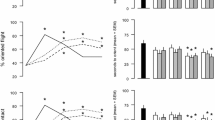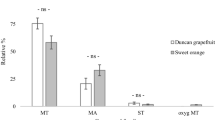Abstract
The attractiveness of different synthetic host odors and a synthetic aggregation pheromone (grandisoic acid [GA]) to overwintered adult plum curculios (PCs), Conotrachelus nenuphar(Herbst) (Coleoptera: Curculionidae), was examined using two types of traps (sticky panels and black pyramids) placed in border areas surrounding an unsprayed section of an apple orchard in Massachusetts. In 2001, we evaluated the response of PCs to three synthetic fruit volatiles (benzaldehyde [BEN], ethyl isovalerate [EIV], and limonene [LIM]) assessed alone and in combination with GA, as well as the response to GA alone and a no-odor (control) treatment. BEN was the only host volatile that synergized the response of PCs to GA for both trap types. For both trap types, GA was as attractive to PCs as a single component as when in combination with either EIV or LIM. In 2002, four release rates of BEN (0, 2.5, 10, and 40 mg/day) and two release rates of GA (1 and 2 mg/day) were evaluated for attractiveness to PCs using panel and pyramid traps. For panel traps, an increase in amount of GA released (from 1 to 2 mg/day) was associated with a 35% increase in captures. However, PC captures by pyramid traps were similar regardless of the amount of GA released. For panel traps, 10 and 40 mg/day of BEN were the most attractive release rates regardless of the amount of GA released. For pyramid traps baited with GA, PC captures were enhanced by the presence of BEN, regardless of release rate. In 2003, GA at 1 mg/day + BEN at 80 mg/day of release did not enhance PC captures by panel traps relative to lower release rates of BEN. Pyramid traps releasing GA at 1 mg/day performed best when baited with BEN at 10 mg/day of release; a release rate of 80 mg/day of BEN decreased the attractiveness of the binary combination of BEN + GA. Combined results suggest that BEN at 10 mg/day + GA at 1 mg/day of release constitutes an attractive lure that may improve the effectiveness of monitoring traps for PCs.
Similar content being viewed by others
References
Alpizar, D., Fallas, M., Oehlschlager, A. C., Gonzalez, L. M., Chinchilla, C. M., and Bulgarelli, J. 2002. Pheromone mass trapping of the west Indian sugarcane weevil and the American palm weevil (Coleoptera: Curculionidae) in palmito palm. Fla. Entomol. 85:426–430.
Bartelt, R. J., Dowd, P. F., Vetter, R. S., Shorey, H. H., and Baker, T. C. 1992. Responses of Carpophilus hemipterus (Coleoptera: Nitidulidae) and other sap beetles to the pheromone of C. hemipterus and host-related coattractants in California field tests. Environ. Entomol. 21:1143–1153.
Borden, J. H. 1984. Semiochemical-mediated aggregation and dispersion in the Coleoptera, pp. 123–149, in T., Lewis (ed.). Insect Communication. Academic Press, London.
Borden, J. H. 1993. Strategies and tactics for the use of semiochemicals against forest insect pests in North America, pp. 265–279, in R. D., Lumsden and J. L., Vaughn (Eds.). Pest Management: Biologically Based Technologies. American Chemical Society, Washington, DC.
Buchbauer, G., Jirovetz, L., Wasicky, M., and Nikiforov, A. 1993. Headspace and essential oil analysis of apple flowers. J. Agric. Food Chem. 41:116–118.
Butkewich, S. L. and Prokopy, R. J. 1993. The effect of short-range host odor stimuli on host fruit finding and feeding behavior of plum curculio adults (Coleoptera: Curculionidae). J. Chem. Ecol. 19:825–835.
Byers, J.A. 1989. Chemical ecology of bark beetles. Experientia 45:271–283.
Chouinard, G., Hill, S. B., and Vincent, C. 1993. Spring behavior of the plum curculio (Coleoptera: Curculionidae) within caged dwarf trees. Ann. Entomol. Soc. Am. 86:333–340.
Dowd, P. F. and Bartelt, R. J. 1991. Host-derived volatiles as attractants and pheromone synergists for dried fruit beetle, Carpophilus hemipterus. J. Chem. Ecol. 17:285–308.
Eller, F. J. and Bartelt, R. J. 1996. Grandisoic acid, a male-produced aggregation pheromone from the plum curculio, Conotrachelus nenuphar. J. Nat. Prod. 59:451–453.
Giblin-Davis, R. M., Peña, J. E., Oehlschlager, A. C., and Perez, A. L. 1996. Optimization of semiochemical-based trapping of Metamasius sericeus (Olivier) (Coleoptera: Curculionidae). J. Chem. Ecol. 22:1389–1410.
Gries, G., Gries, R., Perez, A. L., Gonzales, L. M., Pierce, H. D., Jr., Oehlschlager, A. C., Rhainds, M., Zebeyou, M., and Kouame, B. 1994. Ethyl propionate—synergistic kairomone for African palm weevil, Rhynchophorus phoenicis L. (Coleoptera: Curculionidae). J. Chem. Ecol. 20:889–897.
Hallett, R. H., Oehlschlager, A. C., and Borden, J. H. 1999. Pheromone trapping protocols for the Asian palm weevil, Rhynchophorus ferrugineus (Coleoptera: Curculionidae). Int. J. Pest Manag. 45:231–237.
Hammack, L. 1996. Corn volatiles as attractants for northern and western corn rootworm beetles (Coleoptera: Chrysomelidae: Diabrotica spp.). J. Chem. Ecol. 22:1237–1253.
Hammack, L. 2001. Single and blended maize volatiles as attractants for diabroticite corn rootworm beetles. J. Chem. Ecol. 27:1373–1390.
Johnson, D. T., Mulder, P. G., Mccraw, B. D., Lewis, B. A., Jervis, B., Carroll, B., and Mcleod, P. 2002. Trapping plum curculio Conotrachelus nenuphar (Herbst) (Coleoptera: Curculionidae) in the southern United States. Environ. Entomol. 31:1259–1267.
Lafleur, G. and Hill, S. B. 1987. Spring migration, within-orchard dispersal, and apple-tree preference of plum curculio in Southern Quebec. J. Econ. Entomol. 80:1173–1187.
Lafleur, G., Hill, S. B., and Vincent, C. 1987. Fall migration, hibernation site selection, and associated winter mortality of plum curculio (Coleoptera: Curculionidae) in a Quebec apple orchard. J. Econ. Entomol. 80:1152–1172.
Landolt, P. J. 1997. Sex attractant and aggregation pheromones of male phytophagous insects. Am. Entomol. 43:12–21.
Landolt, P. J. and Phillips, T. W. 1997. Host plant influences on sex pheromone behavior of phytophagous insects. Annu. Rev. Entomol. 42:371–391.
Leskey, T. C. and Prokopy, R. J. 2000. Sources of apple odor attractive to adult plum curculios (Coleoptera: Curculionidae). J. Chem. Ecol. 26:639–653.
Leskey, T. C., Prokopy, R. J., Wright, S. E., Phelan, P. L., and Haynes, L. W. 2001. Evaluation of individual components of plum odor as potential attractants for adult plum curculios. J. Chem. Ecol. 27:1–17.
Lin, H., Phelan, P. L., and Bartelt, R. J. 1992. Synergism between synthetic food odors and the aggregation pheromone for attracting Carpophilus lugubris in the field (Coleoptera: Nitidulidae). Environ. Entomol. 21:156–159.
Oehlschlager, A. C., Chinchilla, C., Castillo, G., and Gonzalez, L. 2002a. Control of red ring disease by mass trapping of Rhynchophorus palmarum (Coleoptera: Curculionidae). Fla. Entomol. 85:507–513.
Oehlschlager, A. C., Gonzalez, L., Gomez, M., Rodriguez, C., and Andrade, R. 2002b. Pheromone-based trapping of West Indian sugarcane weevil in a sugarcane plantation. J. Chem. Ecol. 28:1653–1664.
Perez, A. L., Campos, Y., Chinchilla, C. M., Oehlschlager, A. C., Gries, G., Gries, R., Giblin-Davis, R. M., Castillo, G., Peña, J. E., Duncan, R. E., Gonzalez, L. M., Pierce, H. D., Jr., Mcdonald, R., and Andrade, R. 1997. Aggregation pheromones and host kairomones of west Indian sugarcane weevil, Metamasius hemipterus sericeus. J. Chem. Ecol. 23:869–888.
Perez, A. L., Gries, G., Gries, R., Giblin-Davis, R. M., and Oehlschlager, A. C. 1994. Pheromone chirality of African palm weevil, Rhynchophorus phoenicis (F.) and palmetto weevil, Rhynchophorus cruentatus (F.) (Coleoptera: Curculionidae). J. Chem. Ecol. 20:2653–2671.
Phillips, T. W., Jiang, X. L., Burkholder, W. E., Phillips, J. K., and Tran, H. Q. 1993. Behavioral responses to food volatiles by two species of stored-product Coleoptera, Sitophilus oryzae (Curculionidae) and Tribolium castaneum (Tenebrionidae). J. Chem. Ecol. 19:723–734.
Piñero, J. C., Wright, S. E., and Prokopy, R. J. 2001. Response of plum curculio (Coleoptera: Curculionidae) to odor-baited traps near woods. J. Econ. Entomol. 94:1386–1397.
Prokopy, R. J., Chandler, B. W., Dynok, S. A., and Piñero, J. C. 2003. Odor-baited trap trees: a new approach to monitoring plum curculio (Coleoptera: Curculionidae). J. Econ. Entomol. 96:826–834.
Prokopy, R. J., Phelan, P. L., Wright, S. E., Minalga, A. J., Barger, R., and Leskey, T. C. 2001. Compounds from host odor attractive to plum curculio adults (Coleoptera: Curculionidae). J. Entomol. Sci. 36:122–134.
Racette, G., Chouinard, G., Vincent, C., and Hill, S. B. 1992. Ecology and management of plum curculio (Coleoptera: Curculionidae) in apple orchards. Phytoprotection 73:85–100.
Ramirez-Lucas, P., Rochat, D., and Zagatti, P. 1996. Field trapping of Metamasius hemipterus with synthetic aggregation pheromone. Ent. Exp. Appl. 80:453–460.
STATSOFT, Inc. 1999. Statistica for Windows. Computer program manual. Tulsa, OK.
Tedders, W. L. and Wood, B. W. 1994. A new technique for monitoring pecan weevil emergence (Coleoptera: Curculionidae). J. Entomol. Sci. 29:18–30.
Weissling, T. J., Giblin-Davis, R. M., Gries, G., Gries, R., Perez, A. L., Pierce, H. D., Jr., and Oehlschlager, A. C. 1994. Aggregation pheromone of palmetto weevil, Rhynchophorus cruentatus (F.) (Coleoptera: Curculionidae). J. Chem. Ecol. 20:505–515.
Author information
Authors and Affiliations
Corresponding author
Rights and permissions
About this article
Cite this article
Piñero, J.C., Prokopy, R.J. Field Evaluation of Plant Odor and Pheromonal Combinations for Attracting Plum Curculios. J Chem Ecol 29, 2735–2748 (2003). https://doi.org/10.1023/B:JOEC.0000008017.16911.aa
Issue Date:
DOI: https://doi.org/10.1023/B:JOEC.0000008017.16911.aa




